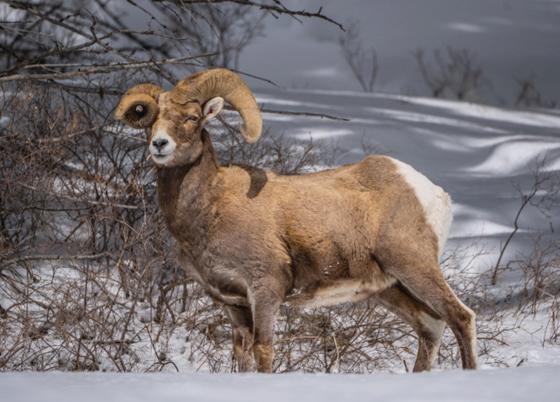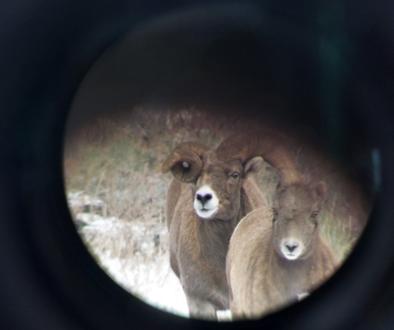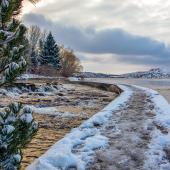RIP: Snailhorn
The long life of a hardy sheep.
In December of 2016, a 4.5-year-old bighorn sheep ram was captured near Quake Lake in the Madison Range, as a part of a statewide disease-surveillance project. The ram was given red ear-tag #79. He was never collared and never transplanted, and he was never captured again. No deformities were noted at the time of his capture.
Perhaps shortly after capture, this ram suffered an injury to the base of his horn. A landowner nearby had seen this young ram challenge an older ram during the rut. The resulting head-strike apparently resulted in cranial damage. Horns are keratin (the same material that fingernails are made of) growing over a bony core, and as keratin continued to grow over the injured bone, it created a unique forward-facing curl, which led to the ram's nickname, “Snailhorn.”
Snailhorn was quite elusive, rarely seen by hunters during the fall and only occasionally observed by the public or by the team of biologists and students who follow bighorn sheep as a part of the research and management activities of Montana Fish, Wildlife & Parks and Montana State University. If he were ever spotted during a survey, it made for special remarks in the data: “We saw Snailhorn today, he’s still alive!” Year after year, he grew bigger, and his curl grew more and more unique.
Although elusive, Snailhorn was unique enough that he eventually gathered the attention of social media. Photos of him went around the state and beyond. Due to these posts, members of the public began asking why FWP did not dart and remove that horn, so that the ram could see better out of his right eye. FWP responded with a KBZK news story, which explained the biology of the horns and the challenges of tranquilizing wildlife. Snailhorn was a healthy bighorn who did not need our intervention. He was occasionally observed sparring with other rams as he pursued mates in the fall. In the winter, he often resided on the benches above Quake Lake with small groups of other rams.
Snailhorn died on March 4, 2023. The cause of death was old age, starvation, and winter stresses. His body showed signs of healing from an accident, perhaps a vehicle strike, which left a flat spot on his left horn that was not seen last year. He was more than 10.5 years old, nearing his 11th birthday—a ripe old age for a Montana ram inhabiting the challenging terrain of the Taylor-Hilgard Wilderness. There have been few rams to reach such an old age in this area.
I would like to thank the many people who sent me sightings of Snailhorn over the years: all the neighbors in the Quake Lake area, all the MSU students who helped me study these sheep, all the game wardens who helped patrol the area, and all the sheep hunters in HD 302. Special thanks to Mr. Kelly Galloup, who found Snailhorn dead beside the road and contacted FWP so we could possess the carcass. Snailhorn will be preserved in a European mount at the FWP regional office, so that everyone can see this example of a bighorn who grew in such an unusual way. His skull will remain property of the people of the state of Montana and will be used for education and outreach.
People who see Snailhorn's mount may feel a variety of emotions. They may feel amazed by how nature works and how the horn grew in such a strange way. They may feel inspired that an animal with a “disability” was able to live a normal and full life. They may feel pity that the animal had this deformity. Snailhorn likely never felt self-pity. As the poet D.H. Lawrence wrote, “I never saw a wild thing sorry for itself. A small bird will drop frozen dead from a bough without ever having felt sorry for itself.”
Rest in peace, Snailhorn. We'll miss you.
The Wild Sheep Foundation (WSF), based in Bozeman, was founded in 1977 by wild-sheep conservationists and enthusiasts. With a membership of more than 10,500 worldwide, WSF is the premier advocate for wild sheep and other mountain wildlife and their habitats. WSF has raised and expended more than $140 million on education, wild-sheep habitat and population enhancement, and conservation advocacy programs in North America, Europe, and Asia to “put and keep wild sheep on the mountain.” These, and other efforts, have increased bighorn-sheep populations in North America from historic lows in the 1950-'60s of 25,000, to more than 85,000 today.















